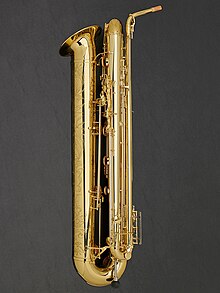
Back Tubax Spanish Tubax French Tubax Italian チューバックス Japanese Tubax NN Tubax NB Tubax Portuguese Tubax Swedish
 | |
| Woodwind instrument | |
|---|---|
| Classification | Single-reed |
| Hornbostel–Sachs classification | 422.212-71 (Single-reed aerophone with keys) |
| Inventor(s) | Benedikt Eppelsheim |
| Developed | First derived in 1999 from the contrabass saxophone |
| Playing range | |
 | |
| Related instruments | |
|
Sizes:
Orchestral saxophones: Specialty saxophones: | |
| Musicians | |
| Builders | |
| Benedikt Eppelsheim | |
The tubax is a modified contrabass saxophone developed in 1999 by the German instrument maker Benedikt Eppelsheim. Although it has the same fingering as the saxophone, Eppelsheim's design reduces the amount of expansion of its conical bore in relation to the length of tubing, resulting in a smaller volume of resonant air column. This allows for it to use a smaller mouthpiece (baritone or bass, instead of a larger contrabass mouthpiece), and more compactly folded tubing. The tubax exists in E♭ contrabass and B♭ or C subcontrabass sizes. Its name is a combination of the words "tuba" and "sax".[1]
- ^ "Interview mit Benedikt Eppelsheim". Saxophonforum: Die deutschsprachige Saxophoncommunity (in German). 13 February 2008. Retrieved 8 September 2023.